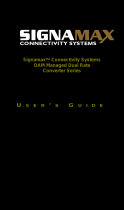
Table of Contents
CHAPTER1INTRODUCTION ................................................................................................................................................................................................6
1.1WELCOME .................................................................................................................................................................................................................................6
1.2PRODUCTDESCRIPTION ................................................................................................................................................................................................................6
1.3PRODUCTFEATURES ....................................................................................................................................................................................................................7
1.4SPECIFICATIONS ..........................................................................................................................................................................................................................8
1.5MANAGEMENTFEATURES .............................................................................................................................................................................................................8
1.6PANEL .......................................................................................................................................................................................................................................9
CHAPTER2INSTALLATION ................................................................................................................................................................................................10
2.1CHASSISOPTIONS......................................................................................................................................................................................................................10
2.2ELECTRICALINSTALLATION...........................................................................................................................................................................................................11
2.3INSTALLATIONOFSFPMODULES .................................................................................................................................................................................................11
2.3.1InsertingaBaleClaspSFPModuleintotheCage .........................................................................................................................................................11
2.3.2RemovingaBaleClaspSFPModule..............................................................................................................................................................................11
CHAPTER3PROVISIONING ...............................................................................................................................................................................................12
3.1WEBLOGIN .............................................................................................................................................................................................................................12
3.1.1Introduction ..................................................................................................................................................................................................................12
3.1.2WebLoginPage ............................................................................................................................................................................................................12
3.1.3WebMainPage ............................................................................................................................................................................................................13
3.1.4SystemInformation,NetworkInformation...................................................................................................................................................................14
3.1.5SystemInformation,DDInformation............................................................................................................................................................................15
3.1.6LocalSettings ................................................................................................................................................................................................................15
3.1.7RemoteSettings............................................................................................................................................................................................................22
3.1.8802.3ahOAMFunctions ...............................................................................................................................................................................................22
3.1.9Tools..............................................................................................................................................................................................................................27
3.1.10Logout .........................................................................................................................................................................................................................30
3.2TROUBLESHOOTING ...................................................................................................................................................................................................................30
3.2.1FactoryDefault. ............................................................................................................................................................................................................30
3.2.2LEDObservations ..........................................................................................................................................................................................................31
3.2.3OperationChecks ..........................................................................................................................................................................................................31
5






















